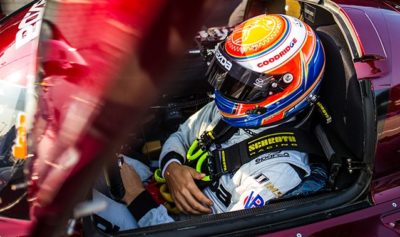The proper seating position means less fatigue and a greater focus on driving.
Racing drivers and car builders spend a lot of time obsessing over seating position. For some, it’s about comfort and control. For others, it’s about getting the center of gravity as low as possible. And safety is always paramount. It may seem like a small thing, especially for sprint racers, but the wrong seating position can be a big problem.
“You have to be comfortable in the car, because if you don’t have support, you get tired really quickly,” explains Harry Tincknell, driver of the No. 55 Mazda RT24-P in the IMSA WeatherTech SportsCar championship. “The G-forces take over, and if you’re not supported enough in the car, your neck is going to be exhausted. I always find that unless I’m fully focused on the driving, I’m not quick. So if I’m worried that I’m getting tired, or I’m thirsty or hot or trying to hold myself in the seat, I’m not going to be fast. You have to do everything you can to be able to focus your mind fully on the driving and not have to worry about the seat or anything like that.”
It’s not just racers and race car builders, though, that obsess over seating position. Mazda’s OEM engineers do as well, and that’s something that can easily be seen in the latest Mazda3. The desire was to create a feeling of connection between car and driver, what Mazda refers to as jinba ittai, the symbiotic relationship between horse and rider. Mazda engineers closely studied human physiology and movement and built the seat and driving position to put the body in the most natural S-shaped curve of the spine to react to movements of the car. It’s a concept that Danny Bender, who both sells and races Mazdas, fully understands and embraces.
“In a race car, everybody is going to sit a little bit different; but the goal is to kind of feel one with the car and feel balanced in it,” says Bender, who competes, and wins, in Touring 3 and has also won in Idemitsu MX-5 Cup presented by BFGoodrich in the same MX-5 Cup car.
“The idea in a race car is that you’re trying to feel the car, and the more feel you have for the car, the better you can control it around the track,” he explains. “You usually try to sit balanced in between the steering wheel and pedals where it feels the most comfortable. The engineers at Mazda can probably give you a six hour seminar about why they did what they did for the seating position and the seat itself, but what they focused on is trying to align the driver in the best seating position possible where you really do feel one with the car.”
In a race car, though, there is also the desire to keep the driver low for both performance and safety reasons, and the seating position must be worked around a roll cage. With the seat in a fixed position, it needs to be right. A driver who has put a lot of miles in a lot of different cars, from Spec Miatas to prototypes, has a pretty good idea of how to get there.
“I start off with height,” says Tom Long, driver coach and professional racer. “Sitting in the car, what’s the visibility like? You want to sit as low as possible in the car, but that needs to be within reason. If you find you’re tilting your head up to look over the dash, that’s an issue; the back of your neck is going to get really tired holding your head up for 30 or 40 minutes. So certainly having the height correct is going to be important – lower than a street car, but high enough that you’re not hindering your visibility.
“Second is your leg length and making sure that when you’re pushing hard on the brake pedal that you still have a bit of a bend in your knee,” Long continues. “The key there is twofold: One, if your leg is fully extended, you don’t have a lot of capability to modulate since you’ll be modulating off your calf muscle or your ankle rather than your bigger muscles. The second piece is the safety aspect – you never want to have your leg locked out like that in a crash because that would cause more damage, where a bent knee acts as a shock absorber.
“The last piece would be your arm length to the steering wheel,” notes Long. “Typically, you’re going to want this closer than what you would in a street car. When your hands are at 9 and 3 on the wheel, you need to have a decent bend in your elbow. The best way to check that is with your arms straight out over the top of the steering wheel, they should be able to break over the top of the wheel without your shoulders coming off the seat too much. The reason for that is purely upper body stamina – you have more control with the wheel closer to you, plus if you’re going through high-load corners and your arms are fully extended, you’re going to wear out your shoulders and your upper arms. If the wheel is a bit closer, you have a lot more leverage on it.”
In a later installment, we’ll discuss more about seating positions, and we’ll throw in the added difficulty of multiple drivers in an endurance race.


 ACCESSIBILITY
ACCESSIBILITY